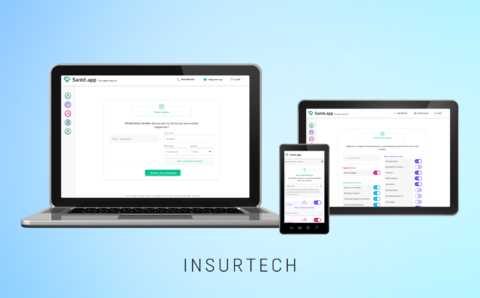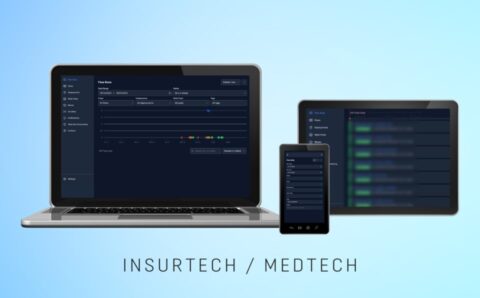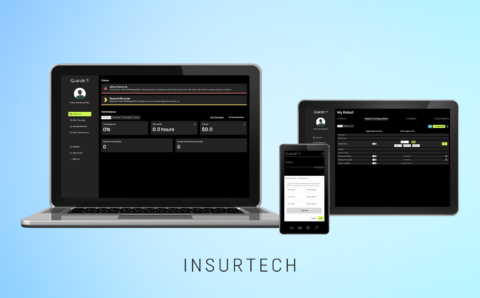
The adoption of digital solutions helps insurance businesses achieve top-tier efficiency, accuracy, and customer satisfaction. Due to this fact, by 2025, 64% of insurance agencies are projected to have fully implemented their digital transformation strategies, as the ZipDo report claims. The software systems are the core of insurance operations, delivering optimized and automated workflow, wise resource allocation, enhancement of customer service to new heights, and elevation of business efficiency.
These benefits are brought by the particular functionality that is guaranteed to make your business thrive. It’s time to explore the top 12 insurance software features that drive the industry’s digital transformation, allowing agencies to become more competitive and provide exceptional service, standing out on the market.
Table of Contents:
Policy Management
A robust insurance software should obligatorily incorporate policy management, as it facilitates the efficient creation, updating, and renewal of insurance policies. With automation capabilities of insurance digital transformation services, agents are able to streamline the flow of policy administration, which frequently comes out time-consuming and complicated. Robotization kills two birds with one stone, minimizing the possibility of human-made mistakes, as well as accelerating the policy lifecycle, and boosting operational efficiency.
Aside from that, insurance software provides centralized storage and seamless extraction of policy data accessibility to authorized personnel. Such a feature assures that the relevant data is available for underwriters, agents, and customer service representatives on diverse appropriate levels, minimizing the response times for customer requests and simplifying administrative flows.
Besides, policy management features may incorporate real-time tracking of policy modifications and endorsements, which helps insurers stay up-to-date with dynamic customer requirements. This way, these opportunities enhance customer service, decrease operational expenses, and guarantee compliance with industry regulations.
Claims Processing
Digital insurance solutions take over claims processing by optimizing this often complex and time-sensitive aspect of the industry. The described feature serves as the inalienable part of efficient and accurate claims management, bringing advantages to both insurers and policyholders.
Claims tracking is another element within this feature essential for insurance software, providing real-time status of claims. This ensures higher transparency and trust between the insurer and the claimant. In addition, document management capabilities ensure the secure storage and retrieval of essential claims-related documents, liquidating outdated paperwork and facilitating quick access to critical data.
Equally indispensable is fraud detection, as fraud remains one of the significant challenges of digital transformation in Insurance. In fact, according to the Insurance Fraud insights, insurance fraud is one of the USA’s most notable crimes, which leads to at least $308.6B stolen annually. Insurance software engages advanced algorithms and data analytics to determine potential fraudulent claims, safeguarding insurers from financial losses.
Combining and integrating these features of the insurance software vastly boosts claims processing, enhances the customer experience, and reduces outgoings. With such functionality, insurers handle claims more swiftly and smoothly, guarantee full compliance with industry regulations, and efficiently provide financial protection to policyholders.
Underwriting and Risk Assessment
Underwriting and risk assessment are processes that can be improved with advanced software solutions to make informed decisions while simultaneously evaluating and pricing risks. This process involves a set of technologies, such as data analytics, artificial intelligence (AI), and predictive modeling, to boost these critical processes.
Data analytics is an integral digital assistant to cope with immense loads of data, covering historical claims, customer demographics, and market trends to identify patterns and tendencies. Based on the delivered data, insurers enhance risk assessment and achieve a more precise analysis of the potential risks related to a policy.
AI is a powerful technology that automates the underwriting process by analyzing large datasets and rapidly pointing out the risk factors. It may be no less useful in optimizing pricing strategies and customizing policies for individual customers, skyrocketing client engagement and retention.
Predictive modeling speaks for itself – it helps insurers forecast future risks and lesions, aiding in enhanced risk management and liquidation strategies.
Customer Relationship Management (CRM)
Customer Relationship Management (CRM) aims to organize and manage policyholders’ information efficiently, which helps improve interactions between the business and client, as well as establish solid and durable relationships in turn. Functionality takes the primary role in managing client interactions, policy data, customer and business interactions, as well as communication, ultimately transforming your newly attracted users into a strong and devoted customer base.
-
- Client interactions. CRM insurance system features allow insurers to review and track every interaction with customers. This incorporates all communication channels, such as phone calls, emails, claims, and policy inquiries. With a comprehensive record of these interactions on hand, agents can deliver a more personalized and efficient service, addressing client pain points and needs effectively.
- Policy information. Insurance software holding CRM capacity stores policy details, facilitating ease of use for both clients and insurance personnel. Clients can check their policies and make updates, while insurance agents have real-time access to relevant policy data, bringing efficiency and handiness to the next level.
- Communication. CRM functionality drives automated communication, such as sending policy renewal reminders, providing updates on claim statuses, and delivering personalized offers. This enhances interaction efficiency and allows insurers to keep abreast with their customers.
Reporting and Analytics
Robust reporting and analytics tools within insurance software offer a wide range of benefits to insurers. These tools open new opportunities for extracting valuable insights from the vast amount of data the industry generates, resulting in improved decision-making and risk management.
-
- Informed decision-making. Reporting and analytics help insurers make data-driven decisions. Businesses can identify trends, customer behavior patterns, and market dynamics to optimize pricing, broking management, underwriting, and product development. Furthermore, insurers can define the opportunities for enhancement and sectors that require more attention.
- Risk assessment. Analytics is the prioritized tool that can evaluate and manage risks more productively. This comprises an in-depth examination of historical data and the employment of predictive modeling. As an output, insurers obtain a precise assessment of the likelihood of claims fraud, as well as market oscillations. Such an analysis allows for more precise risk pricing and strong risk mitigation strategies.
- Operational efficiency. Reporting and analytics tools help monitor and enhance the business’s operational efficiency, determining bottlenecks, boosting processing capacity, and reducing business expenses based on data-driven insights.
Integration Capabilities
The vitality of integration lies in the power to interconnect with external systems and data sources, facilitating seamless performance and data transmission. Integration capabilities are indispensable for those businesses that seek to operate more efficiently, achieve new opportunities, and provide comprehensive services.
-
- Data enrichment. Insurance data integration from external sources allows insurers to extend their internal data with precious external information. It may imply such details as credit scores, property data, and health records, ensuring a more in-depth vision of customers and potential risks.
- Streamlined processes. Third-party application integration can efficiently automate a range of procedures to illustrate claims processing and underwriting. Such a capacity allows the elevation of operational efficiency as well as refining customer satisfaction by reducing delays and failures.
- Regulatory compliance. Many insurance operations require access to external databases for compliance verification. The interconnection helps insurers get the latest and precise information for regulatory purposes.
- Real-time information. By integrating with external systems, insurers get access to up-to-date market insights, obtaining the opportunity to respond to market changes and customer requirements quickly.
Wondering About API Integration Costs?
Get insights into the factors influencing API integration costs and how to budget effectively.
Security Features
Security features should always be prioritized in insurance software as they protect sensitive customer information, financial details, and proprietary company data.
-
- Data protection. Encryption, protecting data from unauthorized access and breaches, is the primary security feature. It verifies that data is kept and transferred in an indecipherable format to any user lacking suitable decryption keys.
- Access control. A solid access control system limits access to authorized parties only, eliminating internal breaches and unauthorized data exposure.
- Compliance. Insurance companies must follow precise data security guidelines and acts. Security features ensure compliance with domain-specific regulations, allowing the avoidance of legal consequences and maintaining trust with policyholders.
- Customer trust. Security breaches often result in reputation damage and customer trust loss. That’s why insurance software security features need to reassure users that their sensitive data is highly protected.
Web and Mobile Accessibility
Mobile accessibility is a critical element of omnichannel experience in the insurance industry. This is where customer convenience and agent productivity are prioritized. The adoption of mobile apps in insurance software has enhanced the way insurers interact with clients and manage their operations.
Mobile apps allow policyholders to access their insurance information, file claims, and keep in touch with agents or ensure customer support from anywhere at any time. This instant access and self-service options elevate the overall customer catering. Thus, insurance experts benefit from mobile accessibility through on-the-go access to policy data, claims processing, and underwriting tools, delivering quicker responses to client inquiries, enhanced client engagement, and more efficient operations. Mobile apps can also provide real-time updates on policy changes, claim status, and other critical data so both customers and insurers can stay up to date and make timely decisions.
Web accessibility is equally vital in ensuring a seamless omnichannel experience within the insurance industry. By prioritizing accessibility on the web, insurers can extend the benefits of seamless and handy interaction to a broader audience, indispensable of the device or platform they leverage. Such an extensive strategy aims at users who may not have access to or prefer not to use mobile applications.
Insurance companies with web accessibility initiatives enable policyholders to manage their accounts, file claims, and communicate with agents through a variety of devices, covering desktops, laptops, and tablets. With this approach, you can enhance the overall reach and usability of insurance services, acknowledging the diverse preferences and needs of their customer base. In addition to facilitating accessibility, web platforms can offer features such as responsive design, ensuring that the user interface adapts to various screen sizes and resolutions. It is critical for a positive user experience, as it allows clients and agents to navigate the insurance portal smoothly, regardless of the device they use.
Billing
The insurance billing process involves several key components, including invoicing, payment collection, and reconciliation. Each of these components should be integrated into the powerful insurance software.
-
- Invoicing and payment tracking. Invoicing is the process of sending policyholders or clients bills for their insurance premiums. Insurance software integrates features to generate and send invoices automatically. Payment tracking allows agents to keep tabs on which clients have paid their premiums and which are unpaid. This way, policyholders are up-to-date with their payments and receive timely reminders or follow-ups.
- Payment gateways. Insurance software essentially interconnects with payment gateways, which are secure platforms for processing payments. They enable users to pay their premiums online by applying various methods such as credit cards, bank transfers, or digital wallets. The integration ensures a seamless and secure payment process.
- Integration with banking systems. It’s important for insurance solutions to integrate with banking systems and robotize payment reconciliation. This implies that when a payment is executed, it is automatically matched with the appropriate policy. Such an approach reduces the need for manual engagement and the risk of human errors, ensuring that financial records are precise and up-to-date.
Upgrade Your Insurance Software
Let our experts tailor a custom API integration solution to boost your insurance software’s capabilities.
Scalability and Customisation
Scalability and customization are two critical factors in insurance software that can greatly impact user engagement, productivity, and effectiveness.
Insurance companies that achieve growth and dynamic changes in their operations must take care of the software scalability, making sure that it can seamlessly adapt to these changes by accommodating increased data, users, or operations without significant disruptions. Consequently, software remains responsive and efficient as the business extends along with the customer base, supporting long-term prosperity.
It’s vital to keep in mind that every insurance business has specific requirements related to service offerings, business operations, or compliance adherence. Therefore, customization opportunities in software allow insurers to tailor the system to address these specific needs precisely. The bespoke approach guarantees that the software fully aligns with the company’s objectives and services and provides a competitive edge in the insurance industry.
User-Friendly Interface
An intuitive and clear interface is of vital significance in insurance software as it directly impacts productivity, user satisfaction, and operational efficiency.
A user-friendly interface helps simplify multistep insurance flows. It makes it straightforward for agents, underwriters, and other engaged parties to navigate the platform. A concise design results in increased productivity as users can execute required tasks more quickly and with fewer errors.
Aside from that, an intuitive interface enhances the user onboarding. This is especially important in the insurance industry, where employees often need to comprehend and deal with complex policy structures as well as compliance needs. Thus, a user-friendly interface cuts down the time and resources required for training, enabling new staff to become productive faster.
The Sante project delivered by PLANEKS is an excellent illustration of robust insurance software with a comprehensive user onboarding process that adapts to individual needs and choices. The platform offers a variety of insurance options, and it’s crucial to provide users with guidance based on their responses. The system incorporates a series of interconnected slides, each containing text, opportunities, and images, implemented to facilitate a seamless user onboarding experience.
In addition, employees working with intuitive software are more prone to be satisfied with their instruments, which, in turn, can lead to improved productivity, easier working process, and reduced turnover. Satisfied customers are more likely to provide better customer service, benefiting policyholders.
The wide range of opportunities brought by insurance software features facilitate modernization and competitiveness. We’ve investigated a row of key elements that should be implemented in the powerful insurance software functionality.
-
- Policy management, claims processing, underwriting, CRM, reporting, and integration. These features address the process’s efficiency, enhance customer service, and deliver data-driven insights for wise and relevant decision-making, as well as risk management.
- Customization, user-friendly interface, and mobile accessibility. The high degree of customization caters to unique requirements, and an intuitive design grows specialists’ productivity, reduces training time, and boosts user satisfaction. At the same time, mobile accessibility elevates customer service and agent productivity.
- Billing, scalability, and security. Billing features manage premiums and payments, whereas scalability ensures adaptability to growth and robust protection safeguards sensitive data.
To truly modernize and stay competitive, insurers should consider custom insurance software development services. Currently, only 34% of insurers agree that they are advanced in their digital transformation journey, according to the ZipDo report. Thus, you are all set to implement solid insurance software and win the market. These critical features tailored to your unique requirements will accelerate your business growth, extend the user base, open new revenue streams, and elevate your profitability.

Santé.app
Our Santé.app platform automates the choice of health insurance, offering a user-friendly interface for comparisons and tailored recommendations.

AI Platform
We introduced an AI-assisted solution that enhances productivity & service quality in healthcare by automating critical administrative processes.

Robot Factory
Robot Factory software automates tasks for insurance brokers, offering efficient document management & significant time savings each month.
You are welcome to share your thoughts and questions in the comments and contact us for more information to start the journey of digital transformation in the insurance industry. Your success depends on your ability to adopt the power of insurance software, so you are all set to become the new market leader.

